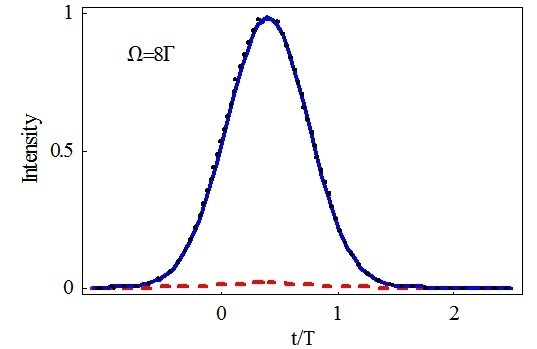QUANTUM INFORMATION PROCESSING
 My scientific interests are focused mainly on Quantum Information science (QIS), which is a new scientific
field with origins in the late 80's and early 90's. It is multidisciplinary by nature based on laser
physics and quantum optics, condensed matter and information theory. QIS holds the promise of
immense computing power beyond the capabilities of any classical computer, it guarantees
absolutely secure communication, and it is directly linked to emerging new quantum technologies.
My scientific interests are focused mainly on Quantum Information science (QIS), which is a new scientific
field with origins in the late 80's and early 90's. It is multidisciplinary by nature based on laser
physics and quantum optics, condensed matter and information theory. QIS holds the promise of
immense computing power beyond the capabilities of any classical computer, it guarantees
absolutely secure communication, and it is directly linked to emerging new quantum technologies.
Below are described important achievements of recent years done in our group.
- An interface between quantum information carriers and quantum information storage and
processors (atoms, ions, solid state) is an integral part of a full-scale quantum information system.
Therefore, a central issue in realization of quantum networks is the effective atom-light interaction.
A particular problem is that, in the telecommunication waveguide, photons display minimal losses at
a wavelength of around 1.5mkm, while atomic-based quantum memories operate efficiently at the
wavelengths in the visible domain of spectrum of light. A method is proposed for efficient frequency
conversion of quantum information based on strong parametric coupling between two single-photon
pulses propagating in a slow-light atomic medium. The transformation of an input qubit at telecom
wavelength into another at at visible domain with near-unity efficiency is realized.

- Motivated by developments in quantum information science, much recent effort has been directed
toward producing single photons on demand for implementation of functional nodes of a quantum
network, where the emitters serve as processing nodes and photons are used for long-distance
quantum communication. For many of these practical applications, it is important that outgoing
single photons have desired frequency and bandwidth, enabling quantum computing with linear
optics, nonlinear optical switching at a single photon level, entanglement swapping and long-
distance transmission over telecommunications wavelengths. A mechanism is proposed to produce
indistinguishable single-photon pulses on demand from an optical cavity. The sequences of two laser
pulses generate, at the two Raman transitions of a four-level atom, the same cavity-mode photons
without repumping of the atom between photon generations. Photons are emitted from the cavity
with near-unity efficiency in well-defined temporal modes of identical shapes controlled by the laser
fields.

- Interaction of quantum light beams with nonlinear media is very weak in quantum information processes and it is necessary to guarantee strong strong atom-light interaction, which requires a combination of large optical nonlinearity, long interaction time, low photon losses that can be achieved via tight confinement of atoms and light in a small volume. This has been recently realized in hollow-core photonic-crystal fibers (HCF). Near to the atomic resonance, the interaction probability between a single atom and a single photon, approaches few percent. In contrast to thermal atoms, where the individual, position dependent coupling for each atom to the field leads to spatial inhomogeneities, in HCF the atomic motion is almost frozen, which slows down the rate of the atom-wall and atom-atom collisions inside the fiber core, thus significantly decreasing the atomic spin relaxation rate. This allows to maximize the collective coupling between the ensemble and the probe field and to minimize position fluctuations keeping, at the same time, the number of atoms fixed. In the future it is planned to use these properties of HCF for efficient realization of quantum information processing. Here are some planned tasks a) study of non-linear magneto-optical effects that are induced in cold atoms. This can serve as a sensitive method to measure weak magnetic fields; b) mapping of radiofrequency information on the state of optical pulses, in order to transfer this information over long distances, which is impossible with radiofrequency information; c) new method of transfer of quantum information between single-photon pulses at different frequencies by means of enhancement of interaction between the photons in cold atomic medium.

- For fast quantum information processing an efficient selective excitation of target atomic states or their superposition in femtosecond timescale is required. A robust and efficient method is suggested and analyzed for population transfer to a desired superposition in multilevel atomic or molecular systems using a train of femtosecond pump pulses or pump-probe technique combined with control lasers. This is of a great importance not only for fast quantum information processing, but also for the control of chemical and biological processes, which occur in femtosecond time-scales. For the first time quantum beats (QB) in the Stokes radiation generated in the stimulated electronic Raman scattering process are studied theoretically. The theory of the QBs in the hyper-Raman scattering and four-wave mixing is developed as well with and without taking into account the laser phase fluctuations.
LIGHT PROPAGATION IN PHOTOREFRACTIVE CRYSTALS IMPRINTED WITH BESSEL STRUCTURE
For the first time we have theoretically observed high order soliton formation in SBN crystal which is imprinted by Bessel beam.